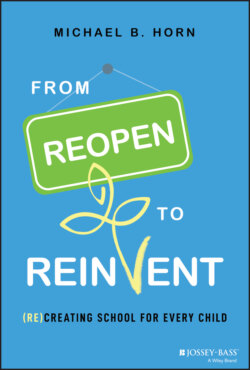Читать книгу From Reopen to Reinvent - Michael B. Horn - Страница 31
What If a District Doesn't Have Enough Internal Capacity?
ОглавлениеGiven scarce resources, overtaxed educators, and constrained work arrangements, many districts will not have the internal capacity to do what Kettle Moraine did.
But just because a given school or district doesn't have the time or resources itself to do this work, it doesn't mean it can't execute on these ideas—nor is it necessary to build from scratch. There are countless schools around the world that have already put in place many innovative ideas from which schools can borrow and adapt. To build the capacity to execute, schools can look to outside groups—be those unpaid community members, parents, consultants, or seasoned service providers—who can fully dedicate time to innovate.
For starters, districts can leverage the significant infusion of federal dollars from the CARES Act. Many have expressed concerns that these dollars may be used to add roles or services that are not sustainable after the funding dries up. But using the money to temporarily stand up an autonomous team like SNHU and Toyota did in order to create a lasting innovation that can roll back into and transform traditional schools is a great use of these recovery dollars.
Wetzler suggested that schools look to things like release time for teachers, after school and summers for intense design sprints, and the use of outside support that can do everything from facilitating design sessions, synthesizing research, or operating as a project manager.
As his cofounder at Transcend Education, Aylon Samouha, said:
In other industries it's worth remembering that that protected time and space for R&D is often not put on the practitioners themselves while they do their jobs. Doctors who were on the front lines of the COVID pandemic were not charged with coming up with the vaccine.
To bring capacity to the table, one approach, according to Samouha, is for an outside group to help a team from a school or district brainstorm for an hour. Even if the team doesn't have the ability to devote hours to the follow-on work, if an outside consultant can do 15 hours of work after the session, then a district starts to get the kind of capacity it needs to fully seize these design efforts as opportunities, rather than remain frozen in place by the threat of what it could otherwise represent.24
Spring Grove Public Schools, a small school district of about 370 students in southeast Minnesota in a town of about 1,200 people, has just one school for all of its K–12 students. Yet it was able to execute significant innovations during the pandemic. One key to its success has been having outside support in the form of a consulting firm, Longview Education, that was there to do everything from compiling research around different design options to helping connect strands of work across the school into something larger and more transformational.
Similarly, microschool providers like MyTechHigh and Prenda Learning partner with districts and schooling systems to help them quickly stand up learning pods with curriculum and teacher support. Prenda Learning, for example, creates groups of five to 10 students in grades K–8. Its enrollments quadrupled during the first year of the pandemic. MyTechHigh, which partners with public schools to offer a full curriculum for K–12 learners at no cost to families, experienced similar rapid growth. As of September 2021, it served more than 18,000 students across seven states—Utah, Colorado, Idaho, Arizona, Wyoming, Indiana, and Tennessee. Some of its more robust partnerships range from the Tooele County School District in Utah to the Vilas School District in Colorado and from the Oneida School District in Idaho to Putnam County Schools in Tennessee and Cloverdale Community Schools in Indiana.
Likewise, there are a multitude of providers that can help stand up full-time virtual schools—or hybrid variations—like Arizona State University Prep Digital, Stride, or Connections Education—or individual courses with teachers, like those just mentioned plus Outschool, Florida Virtual School, Edmentum, New Hampshire Virtual Learning Academy Charter School, and others.
Spring Grove Public Schools:
https://www.youtube.com/watch?v=E6A_ls6JuCU
MyTechHigh:
https://www.youtube.com/watch?v=u9iYz4njgdE
Prenda Learning:
https://www.youtube.com/watch?v=hZPWw0wojIw
* * *
The threat of COVID is no longer new. Early on, schools and policymakers did a good job of marshalling resources. Without the initial threat framing, the massive infusion of federal and local resources and attention would have been impossible. COVID aside, there are many discontinuous changes that educators can frame as threats to seek greater resources, from a specific challenging situation to a new education innovation that has appeared in schools or a changing reality in society or the region.
But framing something as a threat is insufficient. If the goal is to better serve all students, then schools must create an independent team that can shift from seeing the situation as a threat to viewing it as an opportunity. Then this autonomous group will be able to rethink the resources, processes, and priorities of schooling to chase that opportunity. What schools should bear in mind as they do so is where our tale takes us next.
